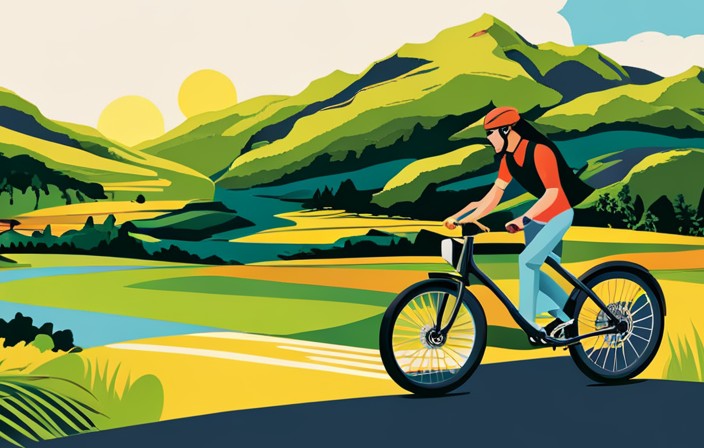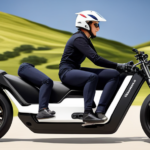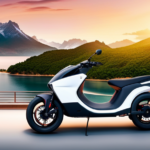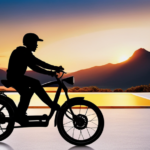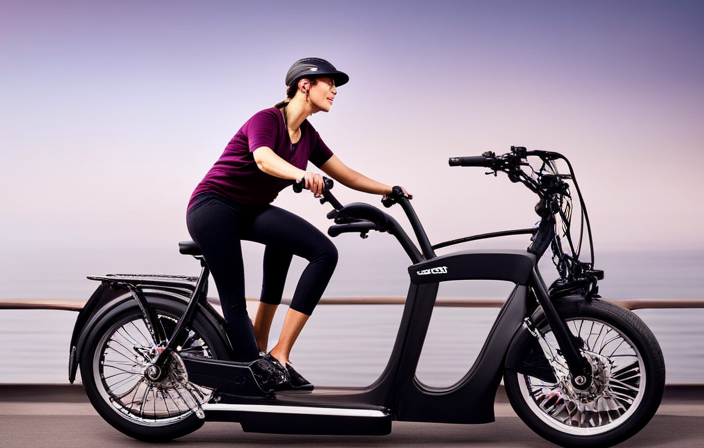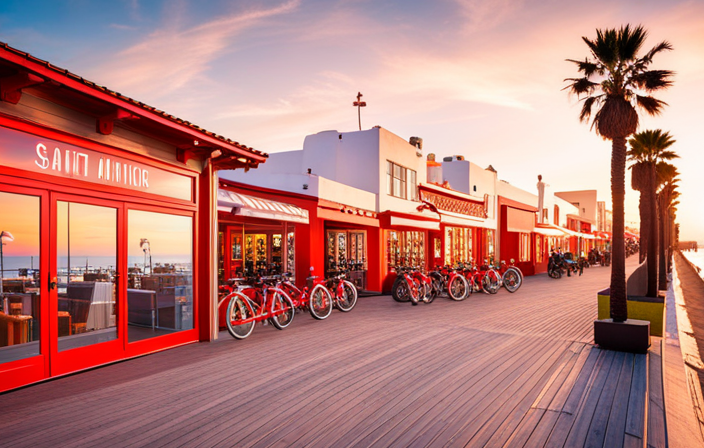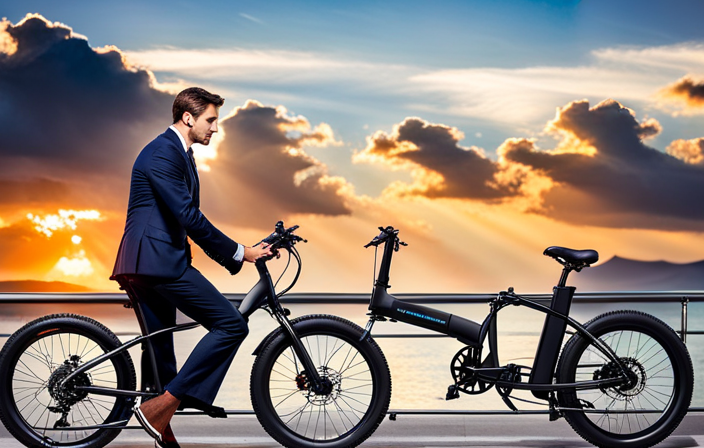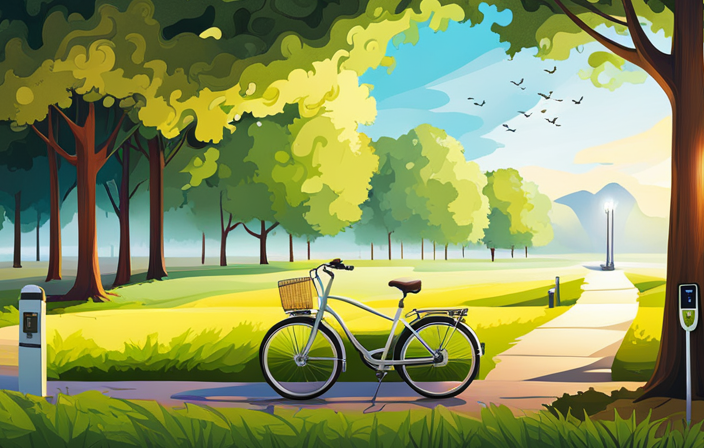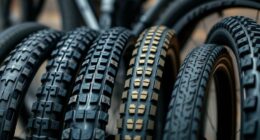Get ready to hit the road on your electric bike and experience the freedom of effortless pedaling! Ever wondered how far you can go on a single charge?
In this article, we’ll explore the factors that determine the range of an electric bike, from battery capacity and motor power to terrain and riding style. Discover expert tips on maximizing your distance, planning efficient routes, and making the most of regenerative braking.
So grab your helmet, buckle up, and let’s dive into the world of electric bike range!
Key Takeaways
- Proper battery management, such as avoiding fully draining the battery and keeping it between 20% and 80% charged, maximizes the lifespan of the battery and allows the electric bike to go a longer distance.
- Regular bike maintenance, including checking tire pressure, lubricating the chain, inspecting brake pads, and regularly inspecting the frame and components, ensures optimal performance and allows the electric bike to go the maximum distance on a single charge.
- Using pedal assist instead of throttle only is more efficient and extends the range of the electric bike, as pedal assist maximizes battery life and requires less effort.
- Choosing the right gear ratio based on terrain, wind, speed, battery consumption, and pedal cadence optimizes pedaling power and conserves battery life, allowing the electric bike to go further.
Battery Capacity and Technology
You can find electric bikes with battery capacities ranging from 250Wh to over 1,000Wh. The battery capacity of an electric bike directly affects how far it can go on a single charge. Generally, the higher the battery capacity, the longer the bike can travel.
However, it’s important to consider the battery lifespan as well. Over time, the battery’s capacity will decrease, reducing the bike’s range. Additionally, temperature can impact the battery’s performance. Extreme cold or hot temperatures can decrease the battery’s efficiency, resulting in shorter distances. Therefore, it’s crucial to store and charge the bike in a suitable environment.
Moving on to motor power and efficiency, these factors also play a significant role in determining the electric bike’s range.
Motor Power and Efficiency
With an electric bike, you can determine the distance it can cover based on the motor’s power and efficiency. The motor power determines the bike’s maximum speed and acceleration, while the efficiency affects the energy consumption. A powerful motor can provide higher torque, allowing you to climb steep hills and ride through challenging terrains effortlessly. However, it may consume more energy, resulting in a shorter range. On the other hand, a more efficient motor can extend the bike’s range by optimizing energy usage. To understand the relationship between motor power, efficiency, and range, refer to the table below:
| Motor Power | Efficiency | Range |
|---|---|---|
| High | Low | Short |
| High | High | Moderate |
| Low | High | Long |
Considering the motor’s power and efficiency is crucial in determining the distance an electric bike can go. Additionally, other factors such as terrain and elevation changes also play a significant role in the bike’s range.
Terrain and Elevation Changes
Consider the impact of terrain and elevation changes on an electric bike’s performance. These factors can greatly affect the distance an electric bike can travel on a single charge. When riding on hilly or mountainous terrains, the motor of an electric bike has to work harder to overcome the increased resistance. This can significantly reduce the overall range of the bike. Additionally, elevation changes can also impact the battery life, as the motor may need to provide more power to climb uphill.
Furthermore, wind resistance plays a crucial role in an electric bike’s performance. Riding against strong headwinds can decrease the range, while riding with tailwinds can extend it. Lastly, the effect of road surface quality should not be overlooked. Bumpy or rough roads can cause additional resistance, resulting in reduced range.
Understanding these factors will help you optimize your electric bike’s performance. Now let’s explore the impact of riding speed and style.
Riding Speed and Style
Riding speed and style greatly affect an electric bike’s performance. When it comes to maximizing your battery range and optimizing your riding experience, it’s important to consider your riding techniques.
Riding at a consistent speed, rather than constantly accelerating and decelerating, can help conserve energy and extend the distance you can travel. Additionally, using the proper gear and pedaling along with the electric motor can decrease the strain on the battery and increase your overall range.
It’s also important to be mindful of your riding style. Aggressive acceleration and braking can drain the battery quickly, whereas a smoother, more controlled approach can help you go further. By understanding these techniques and implementing them into your riding style, you can make the most of your electric bike’s capabilities.
Speaking of capabilities, let’s now discuss how the weight of the rider and cargo can impact an electric bike’s performance.
Weight of the Rider and Cargo
The weight of the rider and cargo can significantly affect an e-bike’s performance. When it comes to electric bikes, the total weight being carried is an important factor to consider. The more weight the bike has to bear, the more power it will require to maintain a certain speed.
Both the rider’s weight and the weight of any cargo being carried will impact the overall distance the e-bike can travel on a single charge. If you are planning to carry heavy loads or have a heavier body weight, it is crucial to choose an electric bike with a higher weight capacity. By doing so, you can ensure that your e-bike will be able to go the maximum distance without draining the battery too quickly.
Now let’s move on to the next section, where we will discuss the impact of tire pressure and rolling resistance on an e-bike’s range.
Tire Pressure and Rolling Resistance
Maintaining proper tire pressure and reducing rolling resistance can greatly improve an e-bike’s range and overall performance. One key aspect of tire maintenance is ensuring that the tire pressure is at the recommended level. When the tire pressure is too low, more surface area of the tire comes into contact with the ground, resulting in increased rolling resistance. On the other hand, if the tire pressure is too high, it can lead to a harsher ride and decreased traction.
Additionally, the tread pattern of the tires also plays a role in reducing rolling resistance. Tires with a smoother tread pattern tend to have lower rolling resistance compared to those with deeper treads. By regularly checking and maintaining tire pressure and opting for tires with lower rolling resistance, you can maximize the range and efficiency of your electric bike.
Now, let’s move on to the next section about weather conditions and temperature.
Weather Conditions and Temperature
Optimal performance of an e-bike can be influenced by weather conditions and temperature. Planning for rain is essential when riding an electric bike, as wet roads can reduce traction and increase the risk of accidents. It is important to ensure that your e-bike is equipped with fenders and mudguards to prevent water splashes.
Additionally, be cautious of how wind can affect your ride. Riding against a strong headwind can significantly decrease your e-bike’s range, while riding with a tailwind can increase it. It is important to consider wind direction when planning your route.
Moreover, extreme temperatures can also impact the performance of your e-bike’s battery. Cold weather can cause a decrease in battery efficiency, while hot weather can lead to overheating. Taking these weather and temperature factors into account will help you maximize the range of your e-bike.
Now, let’s move on to the next section about riding mode and assist levels.
Riding Mode and Assist Levels
When riding an e-bike, you can choose from different riding modes and adjust the assist levels to suit your preferences and desired level of effort. One of the main benefits of pedal assist is that it allows you to engage your leg muscles while still receiving assistance from the electric motor. This means that you can get a good workout while also enjoying the convenience of electric power.
On the other hand, throttle mode allows you to rely solely on the electric motor without any pedaling. This can be useful in situations where you need a quick burst of speed or when you’re feeling tired and need a break from pedaling. Both modes have their advantages and it’s up to you to decide which one suits your needs best.
Now, let’s talk about battery management and charging habits.
Battery Management and Charging Habits
To ensure the longevity of your e-bike battery, it’s important to have proper battery management and develop good charging habits. Battery life is a crucial aspect of electric bikes, and by following some simple guidelines, you can maximize its lifespan.
Firstly, it’s essential to avoid fully draining the battery, as this can lead to irreparable damage. Instead, try to keep the battery between 20% and 80% charged.
Additionally, it’s advisable to avoid exposing the battery to extreme temperatures, as this can also affect its performance and longevity.
Furthermore, make sure to use the appropriate charging infrastructure for your e-bike. Using a charger specifically designed for your bike model will ensure safe and efficient charging.
By adopting these battery management practices and charging habits, you can optimize the lifespan of your e-bike battery and enjoy long rides without worrying about running out of power.
Moving on to bike maintenance and efficiency checks, it’s important to regularly inspect your e-bike to ensure optimal performance.
Bike Maintenance and Efficiency Checks
Make sure you regularly inspect your e-bike to keep it in good condition and running efficiently. Proper bike maintenance is essential for maximizing the performance and longevity of your electric bike.
Here are some key areas to focus on when conducting maintenance and efficiency checks:
-
Tire Pressure: Check the tire pressure regularly to ensure optimal traction and efficiency.
-
Chain Lubrication: Keep the chain properly lubricated to reduce friction and extend its lifespan.
-
Brake Pads: Inspect the brake pads for wear and replace them when necessary to maintain reliable stopping power.
-
Battery Connections: Check the battery connections to ensure they are clean and secure, as loose connections can affect performance.
-
Frame and Components: Regularly inspect the frame and components for any signs of damage or wear, and address any issues promptly.
By diligently maintaining your e-bike, you can ensure it operates at peak efficiency, allowing you to go the maximum distance on a single charge.
Now, let’s explore the topic of using pedal assist vs. throttle only.
Using Pedal Assist vs. Throttle Only
Using pedal assist or throttle only can greatly affect the overall riding experience and level of effort required.
When it comes to efficiency, pedal assist is generally more efficient than using throttle only. With pedal assist, the motor provides assistance while you pedal, making it easier to cover longer distances without exerting as much energy. This can greatly extend the range of your electric bike, allowing you to go further on a single charge.
On the other hand, using throttle only relies solely on the motor power, which can drain the battery more quickly and reduce the overall distance you can travel. Therefore, if you’re looking to maximize your battery life and go the extra mile, pedal assist is the way to go.
Now, let’s discuss how choosing the right gear ratio can further enhance your electric bike’s performance.
Choosing the Right Gear Ratio
When it comes to maximizing your electric bike’s range, choosing the right gear ratio is crucial. Gear ratio selection directly impacts your pedal efficiency, which in turn determines how far you can go on a single charge. By selecting the appropriate gear ratio, you can optimize your pedaling power and conserve battery life.
To make the right gear ratio choice, consider factors such as terrain, wind conditions, and desired speed. A lower gear ratio provides more torque for uphill climbs or against headwinds, while a higher gear ratio allows for higher speeds on flat terrain or with a tailwind.
Here are five important aspects to consider when selecting your gear ratio:
- Terrain conditions
- Wind direction
- Desired speed
- Battery consumption
- Pedal cadence
By understanding these factors and choosing the right gear ratio, you can maximize your electric bike’s range and pedal efficiency. Now, let’s dive into the next section and explore how planning efficient routes can further enhance your electric bike’s performance.
Planning Efficient Routes
To optimize your electric bike’s performance, consider planning efficient routes. Efficient route planning is essential for optimizing battery usage and maximizing the distance you can travel on your electric bike. By carefully selecting your route, you can avoid steep hills and choose paths that are more level, reducing the strain on your battery. Additionally, planning your route to include charging stations along the way can ensure that you have access to a power source if needed. To help you plan your routes effectively, consider using online mapping tools or smartphone apps that take into account elevation and terrain. These tools can provide you with a clear understanding of the distance and elevation changes on your route, allowing you to make informed decisions about the most efficient path to take. By planning your routes in advance, you can make the most of your electric bike’s capabilities and travel longer distances on a single charge. Taking advantage of regenerative braking is another way to maximize your electric bike’s range.
| Advantages of Efficient Route Planning | Tips for Optimizing Battery Usage |
|---|---|
| Reduces strain on the battery | Choose level paths |
| Provides access to charging stations | Plan routes with charging stations |
| Maximizes distance on a single charge | Use online mapping tools |
Planning efficient routes is just one step towards optimizing your electric bike’s performance. Another important aspect is taking advantage of regenerative braking.
Taking Advantage of Regenerative Braking
One way to maximize your e-bike’s range is by taking advantage of regenerative braking. Regenerative braking is a feature found in many electric bikes that allows the motor to act as a generator, converting the kinetic energy from braking into electrical energy that is stored in the battery. By utilizing regenerative braking, you can maximize energy regeneration and significantly extend your e-bike’s range.
Not only does regenerative braking help you go further on a single charge, but it also has a positive impact on battery life. By reducing the strain on the battery, regenerative braking can help prolong its lifespan, ensuring that you can enjoy long rides for years to come.
By now, you understand the benefits of regenerative braking. But there are also other tips for extending your electric bike’s range that you should know.
Tips for Extending Your Electric Bike’s Range
Another useful tip for extending your e-bike’s range is to maintain proper tire pressure.
Keeping your tires inflated to the recommended pressure can significantly impact your electric bike’s performance and battery life. Underinflated tires create more rolling resistance, which requires more power from the battery to overcome. On the other hand, overinflated tires can lead to a harsh and uncomfortable ride.
By regularly checking and adjusting your tire pressure, you can maximize the efficiency of your electric bike and extend its battery life.
Additionally, another way to extend your e-bike’s range is to pedal more. By utilizing the pedal-assist feature and actively pedaling, you can reduce the strain on the battery and go further on a single charge.
Remember, small adjustments and habits can make a big difference in how far your electric bike can take you.
Frequently Asked Questions
Can I use my electric bike in the rain or snow?
Yes, you can ride your electric bike in the rain or snow, but there are some important maintenance tips to keep in mind.
Firstly, make sure your bike is equipped with fenders to prevent water and mud from splashing onto you.
Additionally, regularly clean and lubricate the chain and other components to prevent rust and corrosion.
Lastly, be cautious and ride at a slower speed to ensure better control and safety in slippery conditions.
How often should I charge my electric bike’s battery?
To maximize your electric bike’s battery lifespan, it’s important to charge it properly. The charging frequency depends on your usage and battery type.
As a general guideline, it’s recommended to charge your electric bike’s battery after every ride or when it reaches around 20-30% capacity. However, avoid overcharging as it can shorten the battery’s lifespan.
By following these charging practices, you can ensure your battery remains healthy and reliable for a long time.
Are there any safety precautions I should take when riding an electric bike?
When riding an electric bike, it’s crucial to prioritize safety.
Start with regular bike maintenance, ensuring the tires are properly inflated and the brakes are in good working order.
Wear a helmet, gloves, and reflective clothing to enhance visibility.
Always follow proper riding technique, such as using hand signals, obeying traffic laws, and staying alert.
Additionally, be cautious when riding in adverse weather conditions and avoid distractions like using your phone.
Remember, safety should always be your top priority.
Can I ride my electric bike on hilly terrain?
When riding your electric bike on hilly terrain, it’s important to use proper riding techniques. Shift to a lower gear before you start climbing and maintain a steady pace. Lean forward slightly to distribute your weight evenly and keep your center of gravity low. Pedal consistently and avoid sudden bursts of speed.
The benefits of using an electric bike on hilly terrain include reduced exertion and fatigue, making it easier to conquer challenging slopes.
Are there any restrictions on where I can ride my electric bike?
There are some restrictions on where you can ride your electric bike. While electric bikes can handle hilly terrain, it’s important to be aware of local regulations.
Some bike trails may have restrictions or bans on electric bikes, so it’s best to check before riding. Additionally, certain city streets may have restrictions or designated bike lanes for electric bikes.
It’s always a good idea to familiarize yourself with local laws and guidelines to ensure a safe and enjoyable ride.
Conclusion
In conclusion, the range of an electric bike can vary depending on several factors. Factors such as battery capacity, motor power, terrain, riding style, and weight can all affect how far your electric bike can go.
By considering these factors and making informed choices, you can maximize the range of your electric bike. Remember, planning efficient routes, taking advantage of regenerative braking, and choosing the right gear ratio can all help you go the extra mile.
So, hop on your electric bike and let it take you on a journey filled with endless possibilities.

